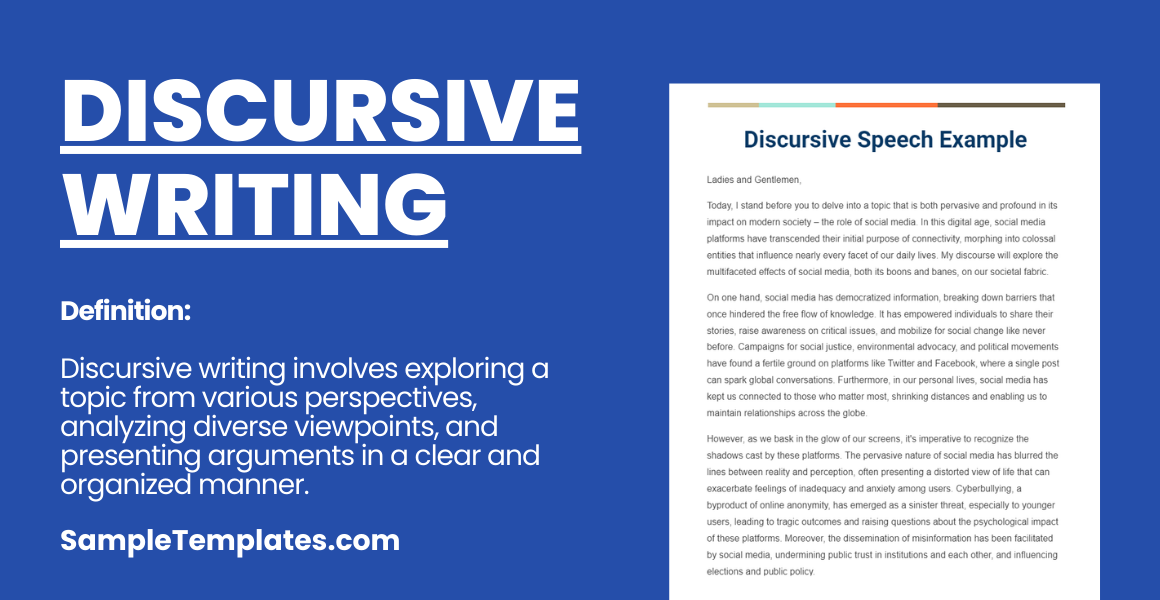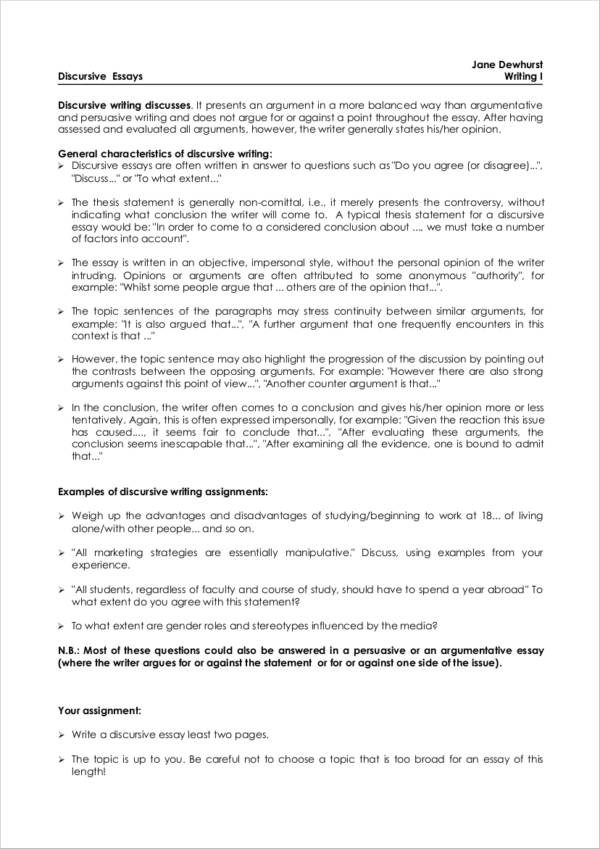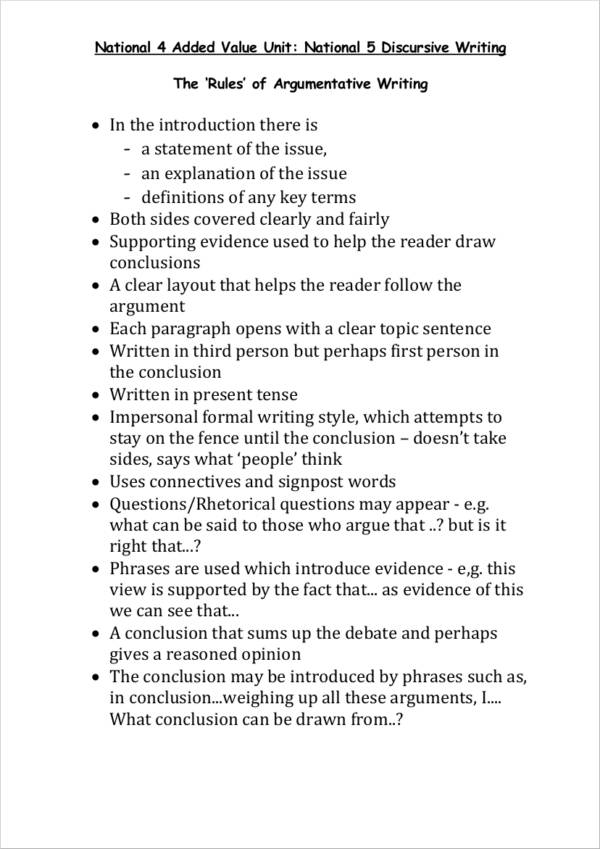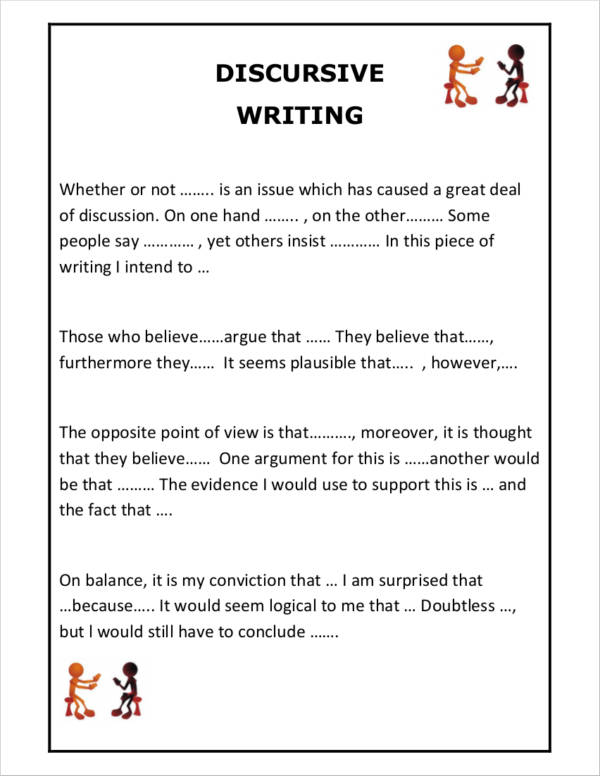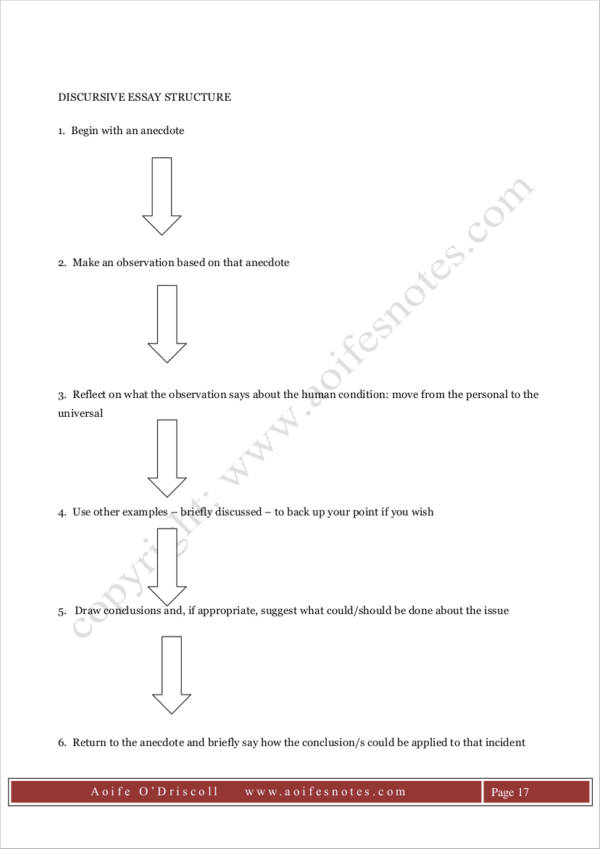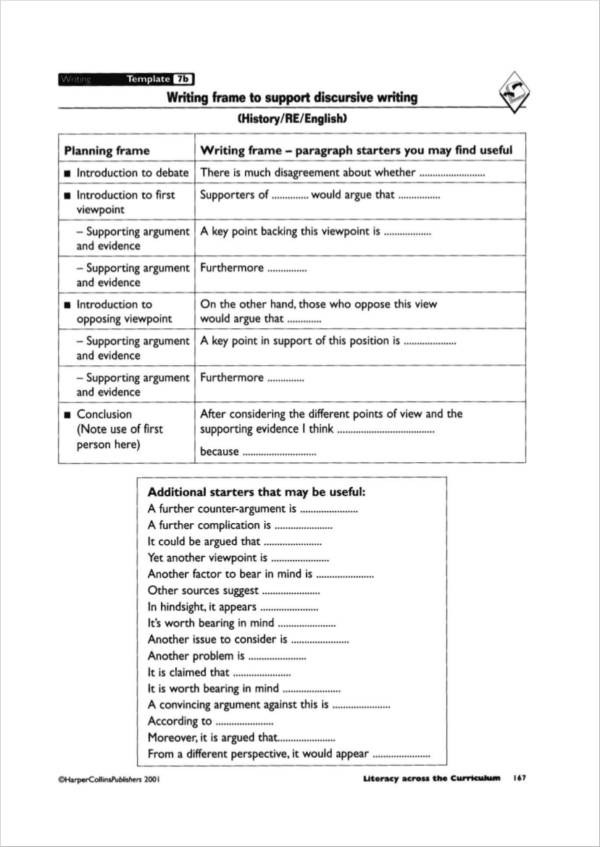Discursive writing can be quite a handful to write. It can also often get interchanged with other types of essays. When it comes to writing one, you want to make sure that you choose a topic that you will be passionate about or objective about. Choosing a topic for this type of writing is of high importance because you want to make sure that you will be able to put a good amount of effort into writing your essay. You may also see book writing
If you are looking for a couple of information about discursive writing, this is the article for you. We have also included a couple of essay samples in PDF that would help you out with coming up with your very own discursive essay.

Download Discursive Writing Bundle
Discursive Paragraph Example
The debate surrounding the use of technology in education illustrates a profound discursive subject that invites a range of perspectives. On one hand, proponents argue that technology enhances learning by providing students with access to a wealth of information and interactive tools that were previously unimaginable. They contend that digital resources, such as educational apps and online platforms, cater to diverse learning styles and can significantly improve engagement and understanding. Furthermore, technology prepares students for a digital future, equipping them with essential skills required in the 21st-century workplace. On the other hand, critics raise concerns about the potential drawbacks of technology in education, such as decreased attention spans, the digital divide, and the potential for distractions. They argue that reliance on technology might undermine foundational skills like handwriting and mental arithmetic. Additionally, there’s an apprehension about screen time affecting children’s health and social skills. This discourse highlights the nuanced balance educators must achieve between leveraging technology to enrich education and preserving traditional learning methods that have proven effective over time.
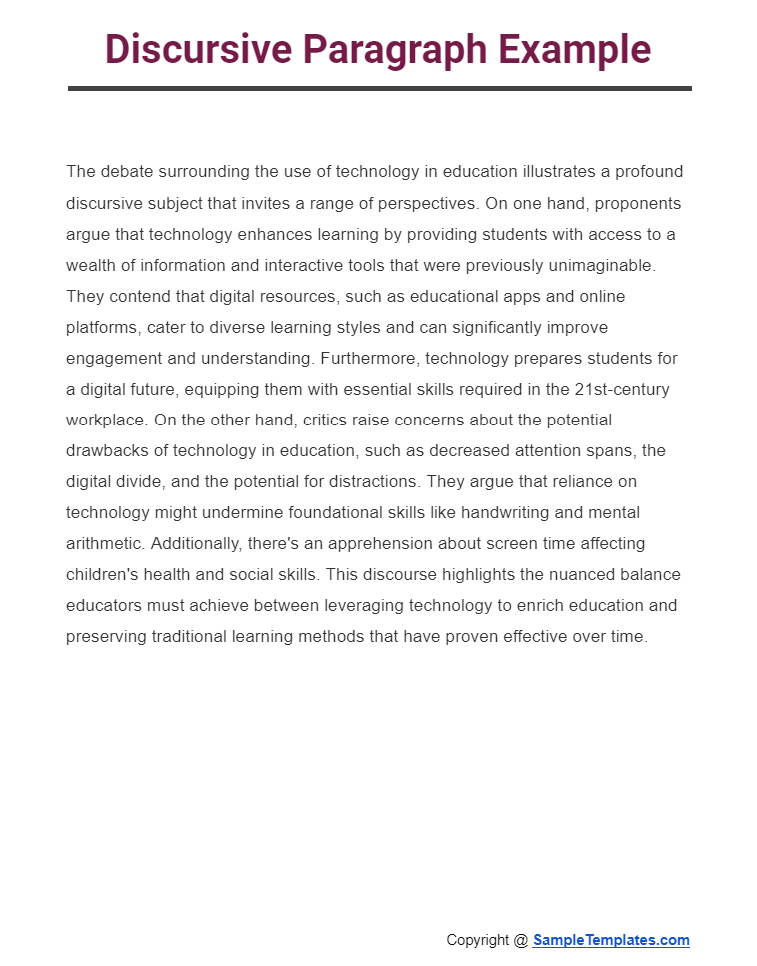
Discursive Speech Example
Ladies and Gentlemen,
Today, I stand before you to delve into a topic that is both pervasive and profound in its impact on modern society – the role of social media. In this digital age, social media platforms have transcended their initial purpose of connectivity, morphing into colossal entities that influence nearly every facet of our daily lives. My discourse will explore the multifaceted effects of social media, both its boons and banes, on our societal fabric.
On one hand, social media has democratized information, breaking down barriers that once hindered the free flow of knowledge. It has empowered individuals to share their stories, raise awareness on critical issues, and mobilize for social change like never before. Campaigns for social justice, environmental advocacy, and political movements have found a fertile ground on platforms like Twitter and Facebook, where a single post can spark global conversations. Furthermore, in our personal lives, social media has kept us connected to those who matter most, shrinking distances and enabling us to maintain relationships across the globe.
However, as we bask in the glow of our screens, it’s imperative to recognize the shadows cast by these platforms. The pervasive nature of social media has blurred the lines between reality and perception, often presenting a distorted view of life that can exacerbate feelings of inadequacy and anxiety among users. Cyberbullying, a byproduct of online anonymity, has emerged as a sinister threat, especially to younger users, leading to tragic outcomes and raising questions about the psychological impact of these platforms. Moreover, the dissemination of misinformation has been facilitated by social media, undermining public trust in institutions and each other, and influencing elections and public policy.
As we navigate this complex landscape, it’s crucial to foster a balanced perspective on social media. Education on digital literacy, emphasizing critical thinking and responsible online behavior, can empower users to navigate social media wisely. Furthermore, advocating for transparency and accountability from tech giants is essential in mitigating the adverse effects of their platforms.
In conclusion, social media stands as a double-edged sword, capable of both uniting and dividing, enlightening and deceiving. As members of this digital society, it’s our responsibility to wield this tool with caution and consciousness, ensuring that its impact enriches, rather than diminishes, the fabric of our society.
Thank you.
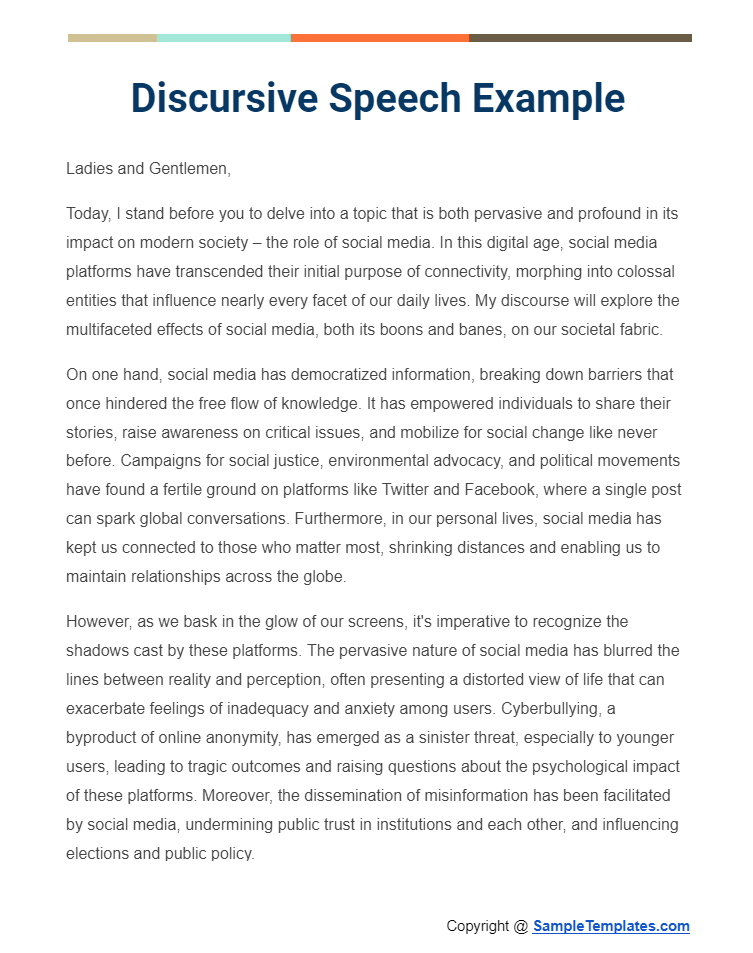
Discursive Article Example
The Digital Age: A Double-Edged Sword for Modern Society
In the contemporary epoch, the digital age stands as a colossal testament to human ingenuity and innovation. It has revolutionized the way we communicate, work, and live, embedding itself into the very fabric of daily existence. Yet, as we navigate through this digital renaissance, it becomes increasingly evident that this new era, much like a double-edged sword, presents both profound benefits and significant challenges to modern society.
On the bright side, the digital age has democratized information, rendering it accessible to a global audience. Knowledge and data, once the privilege of the few, are now at the fingertips of many, thanks to the internet. This has empowered individuals with the tools for self-education, broadening horizons and fostering an informed citizenry. Furthermore, digital platforms have revolutionized social connectivity, enabling people to maintain relationships across vast distances and cultural divides. The business sector, too, has reaped the rewards, with technology driving efficiencies, innovation, and opening new markets that were previously beyond reach.
However, this digital utopia is not without its shadows. The proliferation of digital technology has given rise to concerns over privacy and security. Personal information, once considered private, can now be easily accessed, shared, or even misused, leading to a growing sense of vulnerability among internet users. Moreover, the anonymity afforded by online platforms has fueled a rise in cyberbullying and hate speech, challenging the boundaries of free expression. Another poignant issue is the digital divide, which exacerbates existing inequalities. While some enjoy the full benefits of the digital age, others, particularly in less developed regions, are left on the sidelines, unable to access the same opportunities for growth and development.
The impact of the digital age on mental health also warrants attention. The constant bombardment of information and the pressure to maintain a perfect image on social media can lead to anxiety, depression, and a sense of inadequacy, particularly among younger generations. Additionally, the blurring lines between work and home life in a digitalized world contribute to burnout and stress, challenging the notion of digital technology as a purely beneficial force.
In conclusion, the digital age is a multifaceted phenomenon that brings to light the best and worst of technological advancement. It has undoubtedly propelled society forward, breaking down barriers and fostering innovation. Yet, it also poses significant challenges that require careful consideration and action. Balancing the scales between harnessing the potential of digital technology and mitigating its adverse effects is imperative. As we venture further into this digital frontier, it is crucial to foster a society that is not only technologically advanced but also ethically mindful and inclusive, ensuring that the digital age benefits all of humanity.
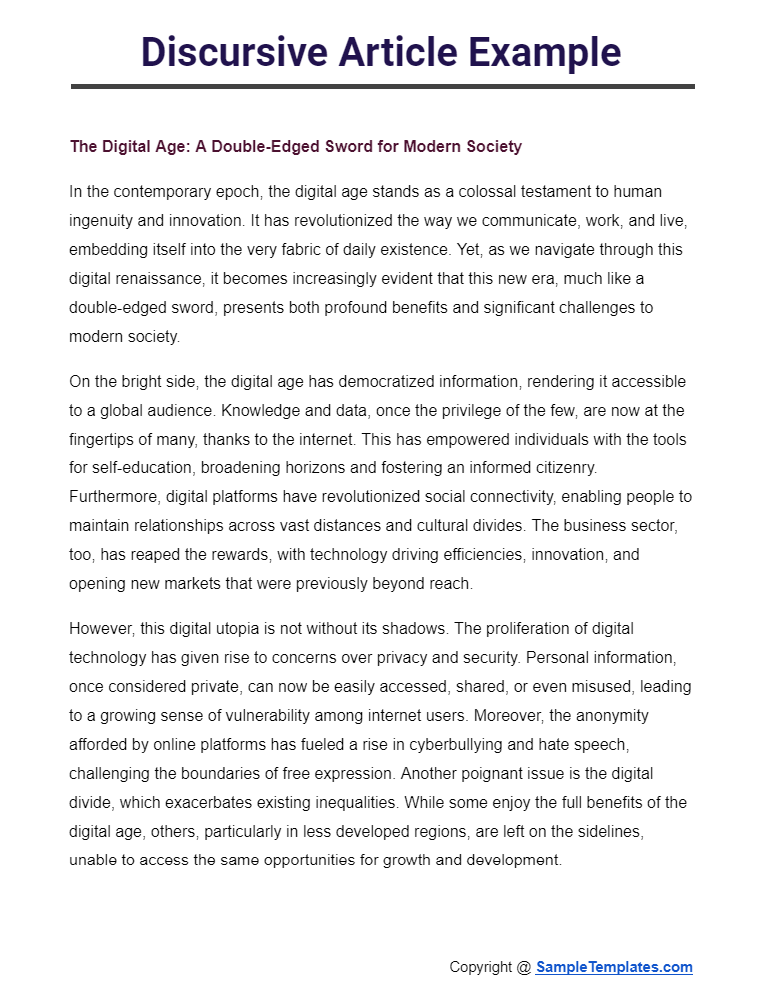
Browse More Templates On Discursive Writing
Sample Discursive Essay in PDF
.What is the format of discursive writing?
Sample Discursive Writing Template
How do you start a discursive writing?
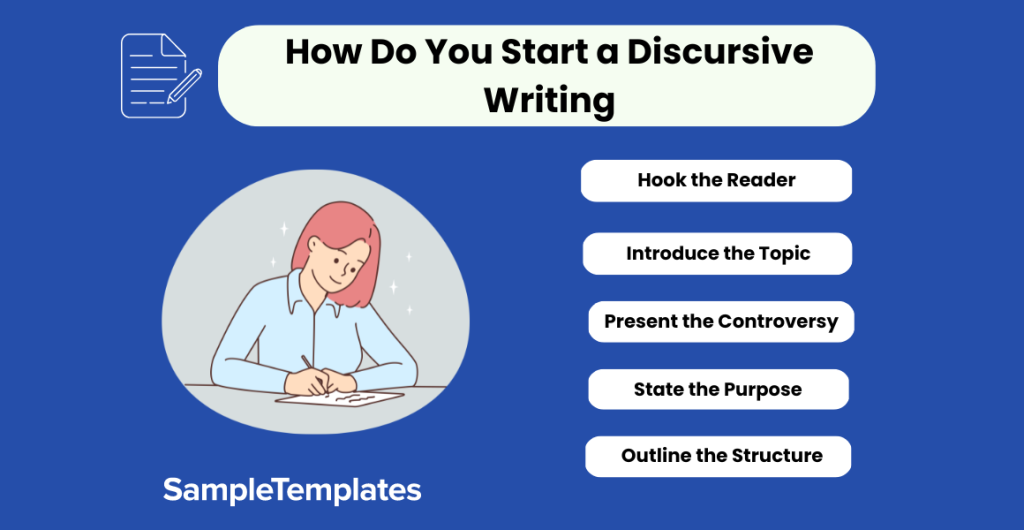
Starting a discursive writing piece effectively involves engaging the reader and laying a solid foundation for the exploration of the topic at hand. Here’s how to craft a compelling introduction:
- Hook the Reader: Begin with a strong hook that piques the reader’s interest. This could be a provocative question, a surprising fact, a quote, or a brief anecdote related to your topic. The aim is to draw the reader in and make them want to learn more.
- Introduce the Topic: Clearly state the topic of your discursive essay. Provide some background information if necessary to help the reader understand the context or significance of the issue being discussed.
- Present the Controversy: Discursive writing explores a topic from multiple perspectives. Introduce the controversy or debate surrounding your topic. Highlight the main arguments or positions without showing bias toward any side.
- State the Purpose: Explain the purpose of your essay. Inform the reader that you will be examining different viewpoints on the topic, weighing their merits, and perhaps drawing a conclusion based on the evidence presented.
- Outline the Structure: Briefly outline how your essay will be structured. Mention the main points or arguments that will be explored in the body paragraphs. This gives the reader a roadmap of what to expect.
Here’s an example introduction for a discursive essay on the impact of social media on society:
“In today’s digital era, social media platforms have become integral to our daily lives, connecting people across the globe in unprecedented ways. Yet, as the digital web weaves itself tighter around our routines, debates rage over its impact on society. Is social media a tool for unparalleled connection and knowledge sharing, or does it serve as a breeding ground for misinformation and social isolation? This essay delves into the multifaceted nature of social media, exploring both its positive contributions and its potential pitfalls. By examining a spectrum of viewpoints, we aim to shed light on this complex issue, offering insights into how social media shapes our modern world.”
This introduction sets the stage for a balanced exploration of the topic, inviting the reader to consider the various dimensions of the issue.
Discursive Writing Template
What Is a Discursive Essay?
Discursive writing is a type of formal writing that discusses a certain topic. The topic can be anything from an issue, a situation, or a problem.
There are two basic types of discursive essays: persuasive essays which aim to persuade the reader that your opinion matters, while the other one is an argumentative essay which basically tries to argue a certain topic based on facts.
There are also three main types of discursive essays:
1. For and against essays which try to discuss the two sides of an issue with justifications, examples, as well as reasons. In the last part of the essay, the writer’s opinion may be written.
2. Opinion essays, based on the word opinion, is a type of discursive writing that presents the writer’s personal opinion regarding a certain topic. The writer’s opinion usually appears in the introduction as well as in the summary of the essay. You may also like business writing.
3. Suggested solutions to problems aim to analyze certain problems to certain topics and discuss possible solutions to these problems. The writer’s opinion may be directly or indirectly stated in the introduction and the conclusion of the essay. You may also check out letter writing
Features of a Good Discursive Essay
Just like any other type of essays, a discursive essay has three basic parts.
1. Introduction
The introduction of a discursive essay will be the part of your essay that will discuss what the main topic of the essay will be. You may also see informational writing
2. Main Body
The main body of the essay will contain the main points of the topic. Typically, it is separated into three paragraphs where the main points will be justified or exemplified.
3. Conclusion
The closing paragraph will summarize everything that you have discussed in the earlier paragraphs wherein your opinions will be restated. You may also like article writing
Considerations with Discursive Writing
1. Present Each Point in an Organized Manner
Every paragraph in the main body of your essay should start with one of the main points that you have for your essay. Justifications should also follow the main points.
2. Catchy Statements
Catchy statements can include
- famous quotations,
- rhetorical questions, and
- thought-provoking questions.
3. List Down Points
When you get started on your essay outline, make sure that you also include the main points that you have. This will help to ensure that you have included everything that needs to be included in the essay. You may also check out reflective writing
4. Formal Language
Keep the language formal and appropriate for the writing style that you have.
The Basic DOs and DON’Ts of Discursive Writing
1. When You are Writing a Discursive Essay, DO
- stick to a formal writing style,
- introduce each main point in a clear and concise statement,
- make sure that your paragraphs are well-developed and well-written,
- give examples for every main point,
- write in a sequential manner,
- properly use linking words, and
- cite sources and references.
You may also see technical writing
2. When You are Writing a Discursive Essay, DON’T
- make use of shortened sentences or phrases,
- make use of informal language,
- make use of language that is biased or emotional,
- over-generalize,
- be insistent on your opinions, and
- make use of personal examples.
You may also like commentary writing
Basic Discursive Writing Template
What are the benefits of discursive writing?
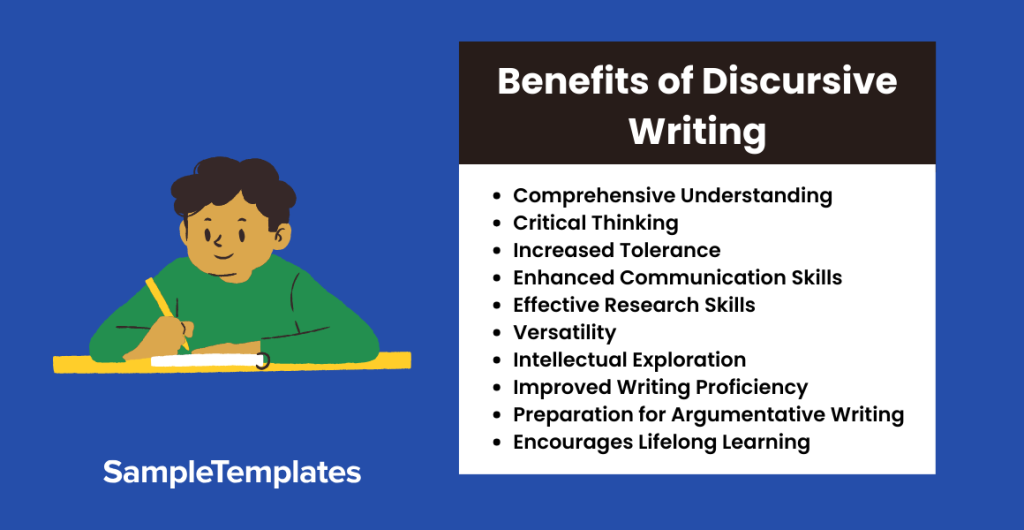
Discursive Essay Writing Format
Discursive Writing Frame Outline Template
What is the difference between discursive and argumentative?
Related Posts
Weekly Schedule Samples & Templates
Contractual Agreement Samples & Templates
FREE 9+ Amazing Sample Church Bulletin Templates in PSD | PDF
Sample Business Card Templates
Sample Cashier Job Descriptions
Questionnaire Samples
FREE 10+ Sample HR Resource Templates in PDF
FREE 10+ HR Consulting Business Plan Samples in MS Word | Google Docs | Pages | PDF
FREE 49+ Sample Job Descriptions in PDF | MS Word
FREE 16+ Nonprofit Budget Samples in PDF | MS Word | Excel | Google Docs | Google Sheets | Numbers | Pages
FREE 13+ Academic Calendar Templates in Google Docs | MS Word | Pages | PDF
FREE 10+ How to Create an Executive Summary Samples in Google Docs | MS Word | Pages | PDF
FREE 23+ Sample Event Calendar Templates in PDF | MS Word | Google Docs | Apple Pages
Company Profile Samples
FREE 10+ Leadership Report Samples [ Development, Training, Camp ]
